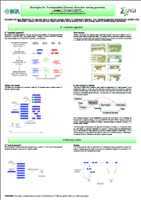
2011
CNET, XVIIe edition 4th - 6th july 2011, Lyon France
04 Jul 2011 Strategies for Transposable Element detection among genomes
O. Inizan, T. Flutre, H. Quesneville
TEs play a major role in genome evolution and their dynamics are particular. Strategies and tools designed for TEs genome annotation have to take into account these particularities. In this study we present a “combined approach” for de novo TEs detection. We choose this strategy because although many algorithms are designed for repeats detection, none is able to take into account all TEs dynamics specificities. Our results show that a combined approach provide a better TEs detection than using a program alone. We have implemented this strategy in a pipeline named “TEdenovo”, a tool of the REPET package .
We also notice that although our tool was benchmarked on well known genomes, automatic TEs detection at genome wide scale reveals the importance of features that have been characterized at a smaller scale: structural variation among families. This event leads us to re-consider the “simple burst” model for TEs evolution and also reveals the limits of designing algorithms on known genomes. We present here a new strategy for TEs detection based on artificial genomes.
Algorithms for TEs detection are designed according to an evolution model and seek to a particular event . For example, GROUPER (Quesneville et al 2005) detects copies from recent burst. Sometimes algorithms reveal “new features” that have not been taken into account by the initial evolution model. In our example, combined approach reveals structural variations among families while algorithms were designed according to the “simple burst” model. In this case, even well known genomes could not contribute to algorithm validation because theses “new features” do not exists in any annotations. Solution reside in creating these features according to an updated model in an artificial genome. We report here first steps in artificial genome creation: (i) generation of a “control” genome for GROUPER and RECON (Bao and Eddy 2002) and (ii) parameters estimation for a “simple burst” generation.
Creation date: 08 Jul 2011
 eZ Publish
eZ PublishPublication supervisor: A-F. Adam-Blondon
Read Credits & General Terms of Use
Read How to cite










